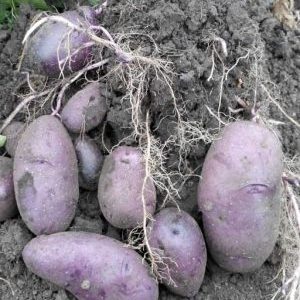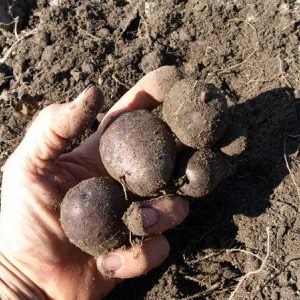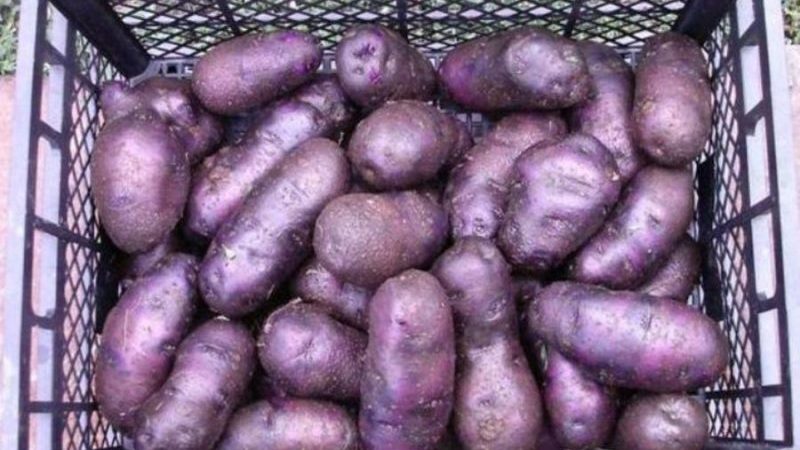An unpretentious potato variety "Chugunka" for regions with a temperate climate and southern regions
Many gardeners prefer proven varieties to newer ones. For decades, only those crops that consistently give a good harvest and have tasty fruits have become popular. This also applies to potatoes.
The potatoes Chugunka are among the time-tested and favorite varieties of summer residents. It has delicious tubers with white flesh and purple skin. What are the advantages and disadvantages of Chugunka and how to grow it on your site - read on.
The content of the article
What kind of potato is this
The cast iron was bred by Russian breeders on the basis of Sineglazka potatoes. The varieties Chugunka and Sineglazka are similar in the photo, but their description and characteristics are different.
It is interesting! Until now, the variety has not been included in the State Register of the Russian Federation, but this does not become less popular among summer residents and gardeners.
The main distinguishing feature of Chugunka is the dark purple color of the rind with yellowish patches on some tubers and creamy or white flesh.

The chemical composition of the variety
The cast iron has a high content of nutrients. It contains anthocyanin, iodine, iron, potassium, magnesium, proteins and amino acids, vitamins of group B, PP, C and K. The vegetable has a positive effect on the endocrine system and the general condition of the body.
Note! People who want to lose weight should take a closer look at Chugunka. It contains only 10-15% starch.
This variety is tasty only when ripe.
General characteristics of Cast iron
Lovers of Chugunka note its excellent taste and ease of care. Therefore, gardeners choose potatoes despite their average yield.
Characteristics of Potatoes Chugunki:
| Parameter | Description |
|---|---|
| Ground part | Has high bushes up to 1 m in height. They are erect, not spreading, compact, intermediate type. The plants are highly leafy. The leaves are medium in size, have a wavy edge and pronounced veins, the color is dark green. Compact corollas consist of large lilac flowers. The root system is powerful. Each plant forms up to 10 tubers. |
| Tubers | Medium size. The weight of each varies between 90-130 g. The glossy rind is purple in color with a bluish tint. Some tubers have light yellow spots on the skin. There are few eyes, but they have a more saturated blue color. Usually depressed or convex. The shape is aligned, oval.
The pulp is creamy or white in color, often with a thin purple ring. The taste is full-bodied with a pronounced aroma. The starch content is 10-17%. Contains many beneficial substances. When heat treated, the pulp does not darken and turns out to be tender and rich. |
| Ripening terms | The variety is early maturing. The first crop is harvested 70-75 days after sowing the tubers. |
| Yield | Average. From 1 hectare, 100-200 centners are harvested, depending on the care, soil composition and climatic conditions. There are few non-commodity tubers. |
| Transportability | High. The skin is dense, allowing the tubers to be transported over long distances. The harvested crop is stored throughout the winter without losing its taste. |
| Disease immunity | It is immune to all potato diseases, except late blight. |
| Growing features | Suitable for growing in all regions of our country. |
Advantages and disadvantages
The advantages of Chugunka include:
- great taste;

- high content of nutrients;
- interesting appearance of purple tubers;
- early maturation;
- immunity to major diseases of the nightshade;
- high keeping quality;
- a small number of non-marketable tubers;
- high portability;
- drought resistance.
Disadvantages of the variety:
- low productivity;
- exactingness to the composition of the soil;
- degenerates with prolonged use of the same planting material.
Agrotechnics Chugunki
In the central and southern regions landing potatoes are dealt in April. By this time, the soil at a depth of 15 cm warms up to 10 ° C. In cities with cold climates, tubers are planted in early May.
Agrotechnics Chugunki is not much different from caring for any other potato. The only caveat is that the variety is especially picky about feeding.
Preparation of planting material
1-1.5 months before planting, potato tubers must be prepared. First, the planting material is processed. This accelerates the emergence of sprouts, reduces the likelihood of disease in the future and increases the plant's resistance to adverse environmental factors.
Potatoes are processed before planting using:
- A solution of 3 liters of water and 1 tsp. copper sulfate. Tubers within 5-10 minutes. After that, they are dried for 12 hours.
- Means from 1 tsp. boric acid and 6 liters of water. The planting material is washed in it for 5 minutes. Then it is left to dry completely.
- "Solution" or any other growth stimulant, diluted according to the instructions on the package.
After processing, the potatoes are germinated. To do this, it is placed in wet sawdust in a dark place or simply left in the light. It is important to constantly spray the tubers so that they do not dry out.
For planting, use large and beautiful tubers with strong sprouts. 2 days before planting potatoes on the beds, they are taken out to a place with a temperature of + 10 ... + 12 ° C.
Advice! For planting, tubers are chosen from those plants that did not hurt and gave the best harvest last season.
Preparing the beds and planting
For potatoes, beds are chosen in a lighted area of the garden. In the shade, this light-loving crop has lower yields.
Light, but nutritious soils are best suited for Cast Iron. In heavy soil, the yield is significantly reduced.
Every 2 years, the place for planting potatoes is changed. At this time, the plots are sown with legumes, radishes, rye, any herbs, carrots, cabbage, onions or garlic. After nightshades, Pig iron is not planted... They, in turn, are not placed next to potato beds.
Preparation of the site for planting potatoes begins in the fall. The beds are dug up and cleaned of plant residues. If the plants are not sick, then they are not thrown away, but crushed and buried in the ground.

For each 1 m² of the plot, 6-8 kg of manure or humus are applied. If the soil is acidic, then add ash.
In the spring, the beds are dug again to a depth of 30 cm and cleaned of vegetation. For each 1 m² add 15 g of urea and 30 g of superphosphate.
The wells are placed at a distance of 30 cm from each other. A distance of at least 60 cm is left between the rows.The depth of the holes is from 6 to 10 cm.
Before planting, a handful of ash or long-acting granular fertilizers are thrown into each hole. Then potatoes are placed there, watered with warm water and covered with soil.
Basic rules of care
To get a high yield of tasty and beautiful potatoes, as in the photo, you need to provide them with proper care.
The list contains basic rules:
- Until the planted potatoes germinate, the beds are loosened once every 2-3 days. This is done with a rake. In the process of loosening, weeds are also removed.
- Before emergence, the beds are watered only if the ground is dry.
- Potato beds are watered three times per season. The first time - before flowering, the second - after flowering, the last - after the plants have faded.Up to 3 liters of liquid at room temperature are poured under each bush. If it rained several times in the summer, then this is not necessary. The cast iron pot is drought resistant.
- After each watering or rain, the soil is loosened. This is necessary to destroy the earth crust, which prevents air exchange. When loosening, the beds are weeded.
- Potatoes must be spilled - this increases the yield. The first hilling is done when the bushes grow up to 15 cm. The second - after 3-4 weeks. The land is taken from the row-spacing and raised with ridges to a height of 6 cm.
- Potatoes are fed three times a season. If long-acting mineral fertilizers were laid in the holes, such funds are not used. It is enough 2 weeks after the emergence of seedlings, the first bud, and with abundant flowering, pour 1 liter of organic solution under each course. It is prepared from 1 kg of chicken manure, 1 tbsp. ash and 10 liters of water.
- 2 weeks before harvesting, the plants are sprayed with a superphosphate solution (25 g per 10 l of water). This will increase the yield.
Tips from experienced summer residents
Experienced gardeners use several secrets that will make it easier to care for potatoes and increase yields:
- To save planting material, it is recommended to plant cut tubers. To do this, the sprouted roots are cut with a knife disinfected with alcohol so that a sprout always remains on each part.
- Only large tubers are chosen for planting. Small specimens lead to the degeneration of the variety.
- It is recommended to plant basil, thyme and other spices between the rows of potatoes. They reduce the risk of disease and plant pests.
- In the fall, after harvesting the potatoes, it is recommended to sow rye in the beds. In the spring, 2 weeks before sowing the tubers, the soil is dug up and watered with chicken droppings or a solution of humus. This increases the fertility of the soil.
- The beds are covered with a layer of mulch. Use hay, straw, or humus. This protects plants from pests and negative environmental factors.
- No other nightshades are planted near the potato beds. It is the potato that is considered the carrier of many diseases and pests.
- Watering, root and foliar dressing is done early in the morning or late in the evening. This will reduce the likelihood of burns on the plant.
- Top dressing is applied the next day after watering or precipitation. Otherwise, fertilizers injure the tubers.
Diseases and pests
The cast iron is resistant to most diseases common to nightshade crops. During epidemics, late blight sometimes affects it. Therefore, it is recommended at the end of summer to spray the bushes with a solution of copper sulfate (1 tablespoon per bucket of water) twice a week.
To prevent infestation of potatoes, it is important:
- observe crop rotation;
- disinfect tubers, soil and garden tools;
- follow the rules of watering and feeding;
- regularly loosen the soil and remove weeds.
Pests are less likely to infest a cast iron pot than other colored potato varieties, but such a problem is not excluded.
The plants will be protected from the Colorado potato beetle by spraying with a decoction of bitter herbs (wormwood, celandine, yarrow, dandelion) or sprinkling the rows and bushes with ash. If the pest has already started, beetles and larvae are harvested by hand. A more drastic measure is to spray the potatoes with chemicals, for example "Barrier", "Taboo" or "Lightning".
It is more difficult to fight the wireworm and the bear. These pests do not affect leaves and stems, but tubers. Prevention is considered to be digging the soil before planting and removing the larvae. Pests do not like slightly acidic soils.
Harvesting and storage

Pig-iron harvest is ready for harvest in mid-July. Dig up the tubers with a pitchfork to reduce the likelihood of damage.
The readiness of the crop for harvest is determined by the appearance of the plant. When the tubers reach maturity, the bushes turn yellow and wither.
The dug tubers are dried and cleaned from the ground with a dry cloth. All damaged copies are stored separately and used as soon as possible.The potatoes are put in clean boxes and stored in a dry room, which is previously fumigated with sulfur.
Best of all Cast iron is suitable for baking and making puree. It boiled down and it turns out to be soft and crumbly.
Farmers reviews
Reviews of farmers about Chugunka are mostly positive. Despite the average yield, farmers continue to grow this variety.
Inna, Ryazan: «A couple of years ago, I first planted Chugunka. Found some unusual purple tubers on the market. The harvest is really average, but the fruits are very tasty, tender and crumbly. The variety is susceptible to late blight, so I spray all nightshades in the area with copper sulfate. "
Victor, Tver: “I have been growing the pot for more than one year. Potatoes are ideal for mashed potatoes. Productivity suits, rarely gets sick. The only problem is pests. Found a way to deal with the Colorado potato beetle. We negotiate with our neighbors and in one day we collect all the beetles and larvae in our plots. After that the insects don't attack. "
Read also:
An early ripe, frost-resistant potato variety "Rosalind".
Conclusion
Chugunka is a potato that will appeal to novice and experienced gardeners. It is characterized by its drought tolerance and a stable yield. Thanks to this, it is easy to grow it in the country, coming there only once a week.
The only drawback of Chugunka is the average yield. Lovers of purple potatoes forgive her for their delicate taste and rich aroma of tubers.